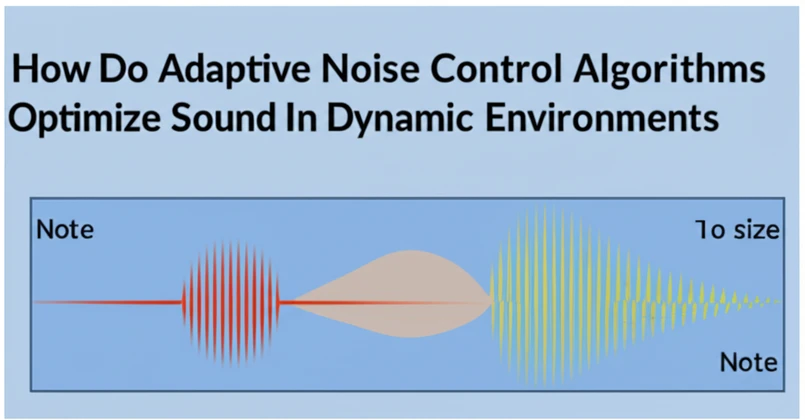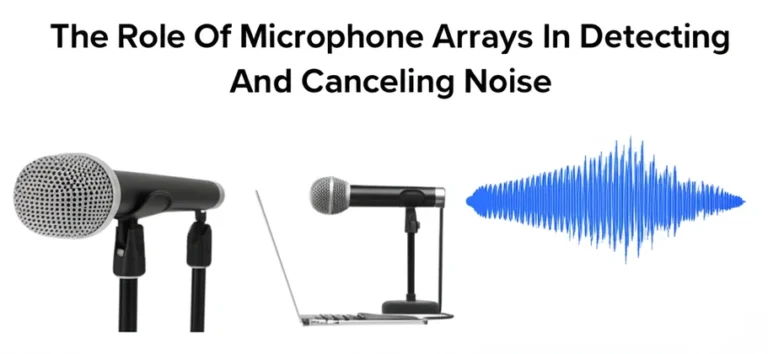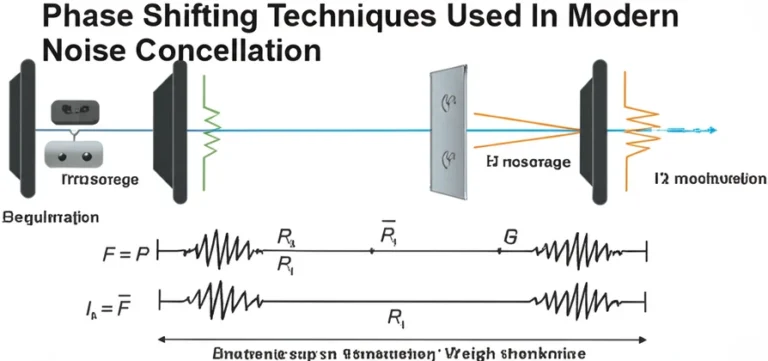
Adaptive noise control algorithms use real-time data processing to adjust sound cancellation in ever-changing noise conditions, providing a superior auditory experience across diverse environments like offices, vehicles, and public spaces. For example, imagine enjoying a crystal-clear phone conversation in a bustling airport terminal, or experiencing the tranquility of a quiet car cabin despite heavy traffic noise. These are just glimpses of the potential of adaptive noise control, a technology revolutionizing how we interact with sound in dynamic environments. This article explores how do adaptive noise control algorithms optimize sound in these challenging scenarios, delving into their inner workings, diverse applications, notable benefits, and the cutting-edge innovations shaping their future.
Noise in dynamic environments, from the cacophony of a city street to the murmur of an open-plan office, is notoriously unpredictable, constantly fluctuating in both intensity and frequency.
Managing these sound variations requires advanced solutions that go beyond traditional noise reduction methods. Adaptive noise control algorithms address this challenge by analyzing and responding to noise in real-time, providing a dynamic and effective approach to sound management.
How Do Adaptive Noise Control Algorithms Work?
Adaptive noise control algorithms operate on the principle of destructive interference, using specifically generated anti-noise to counteract unwanted sounds. The core of this process lies in a sophisticated feedback loop mechanism.
Key Principles of Adaptive Noise Cancellation
- Noise Detection: A reference microphone captures the ambient noise, converting the sound waves into digital signals.
- Signal Processing: The digital signal is then fed into an adaptive filter.
This filter, the heart of the system, analyzes the noise profile, identifying its frequency components and amplitude characteristics. Common adaptive algorithms include the Least Mean Squares (LMS) algorithm, known for its simplicity and efficiency, and the Recursive Least Squares (RLS) algorithm, which offers faster convergence but higher computational complexity.
- Dynamic Adjustment: Based on the analysis, the adaptive filter generates an anti-noise signal. This signal is then emitted by a loudspeaker, creating a zone of destructive interference.
The error microphone, placed near the listener’s ear, monitors the residual noise after cancellation. This feedback is used to continuously adjust the adaptive filter’s parameters, optimizing the anti-noise signal for maximum effectiveness even as the ambient noise changes.
The Role of Real-Time Data
Unlike traditional passive noise cancellation methods that rely on fixed sound barriers, adaptive noise control continuously monitors and adapts to fluctuating noise levels. This real-time processing capability ensures consistent performance even in highly variable environments, optimizing the auditory experience second by second.
Applications of Adaptive Noise Control Algorithms
The ability of adaptive noise control algorithms to optimize sound in dynamic environments makes them invaluable across a spectrum of applications.
Consumer Electronics
Noise-canceling headphones utilize adaptive noise control to create an immersive listening experience.
As you move from a noisy street to a quiet cafe, the headphones dynamically adjust to suppress the changing background noise. This technology has become increasingly sophisticated, with some headphones incorporating multiple microphones and advanced AI algorithms to personalize the noise cancellation experience.
Automotive Systems
Modern vehicles incorporate adaptive noise control to mitigate engine, wind, and road noise, dramatically enhancing passenger comfort. By actively counteracting these unwanted sounds, the system creates a quieter cabin, reducing driver fatigue and improving the overall driving experience.
Studies have shown that noise reduction in vehicles can significantly decrease stress levels and improve concentration.
Industrial Workspaces
In industrial settings with loud machinery, adaptive noise control systems play a vital role in protecting workers’ hearing. These systems continuously analyze the complex sound patterns generated by industrial equipment and dynamically adjust the noise cancellation to minimize exposure to harmful noise levels, contributing to a safer and more productive work environment.
Smart Cities and Public Spaces
Adaptive noise control is increasingly being deployed in smart cities to manage urban soundscapes. Smart noise barriers and noise-absorbing installations equipped with adaptive algorithms can dynamically adjust to traffic patterns and other urban noise sources, creating more livable environments.
For instance, a smart barrier near a school could reduce traffic noise during school hours while allowing ambient sounds to pass through at other times.
Benefits of Adaptive Noise Control Algorithms
Precision and Flexibility
Adaptive noise control excels in targeting specific noise sources while dynamically adapting to changing soundscapes. This precision and flexibility make it suitable for a diverse array of environments and noise profiles. The ability to adapt in real-time distinguishes it from traditional noise control methods which are often limited in their effectiveness against fluctuating noise sources.
Improved Comfort
By effectively minimizing unwanted noise, adaptive noise control systems contribute to enhanced comfort in both personal and professional settings.
Reducing noise pollution allows for better concentration, reduced stress levels, and protection from noise-induced hearing loss. Studies have linked prolonged exposure to noise with negative health outcomes, highlighting the importance of effective noise management solutions.
Energy Efficiency
Modern adaptive noise control algorithms are designed with energy efficiency in mind. Optimizations in processing power and algorithm design allow these systems to deliver exceptional performance without excessive energy consumption, making them sustainable and practical for widespread deployment.
Innovations in Adaptive Noise Control
AI-Driven Algorithms
Artificial intelligence is transforming adaptive noise control.
AI algorithms can learn and predict noise patterns, optimizing system performance for individual users and specific environments. This personalized approach allows for more precise and effective noise cancellation. For example, AI algorithms can differentiate between speech and background noise, allowing for selective noise cancellation that preserves desired sounds.
Hybrid Noise Control Systems
Hybrid systems combine the strengths of adaptive and passive noise control techniques, providing superior noise reduction across a broader frequency range.
By integrating active noise cancellation with sound-absorbing materials, these systems can effectively tackle a wider variety of noise sources, delivering improved performance in complex environments.
Integration with IoT
Connecting adaptive noise control systems with the Internet of Things (IoT) opens up new possibilities for seamless environmental sound management. In smart homes and cities, IoT integration allows for coordinated noise control across multiple devices and locations. Imagine a smart home system that automatically adjusts noise cancellation based on real-time noise levels detected by external sensors, creating a personalized soundscape throughout the house.
FAQ
How do adaptive noise control algorithms differ from traditional noise cancellation?
Traditional noise cancellation typically utilizes passive methods like sound-absorbing materials or pre-set sound profiles.
Adaptive algorithms, on the other hand, actively analyze and adjust to changing noise conditions in real time, providing more consistent and effective noise reduction, especially in dynamic environments.
Are adaptive systems suitable for unpredictable noise?
Yes, adaptive systems are specifically designed to handle unpredictable noise. Their continuous analysis and real-time adjustments make them highly effective in fluctuating noise environments where traditional methods often fall short.
Do adaptive algorithms consume more energy?
While adaptive systems require more processing power than passive methods, modern algorithms prioritize energy efficiency. Advancements in algorithm design and hardware have significantly reduced power consumption, making them practical for a wide range of applications.
Can adaptive noise control be used in open spaces?
Adaptive noise control can be implemented in open spaces using strategically placed speakers and microphones.
However, the effectiveness can be influenced by factors like the size of the area and the complexity of the noise sources. Localized zones of quiet can be created, but complete noise cancellation in a large open space remains a significant challenge.
What are the limitations of adaptive noise control?
Adaptive noise control is most effective at canceling lower-frequency, predictable noises. High-frequency, rapidly changing sounds are more challenging to counteract effectively.
Additionally, performance can be affected by factors such as wind and temperature variations. Furthermore, the physical placement of microphones and speakers is crucial for optimal performance.
Conclusion
Adaptive noise control algorithms represent a significant advancement in noise management technology. By dynamically responding to changing acoustic environments, these systems enhance comfort, productivity, and auditory experiences across various applications.
From personal devices to public spaces, adaptive noise control algorithms are reshaping how we interact with sound in our daily lives. Ongoing research in areas like AI-powered algorithms and hybrid systems promises even more sophisticated and effective noise control solutions in the future, creating quieter and more comfortable environments for everyone.






